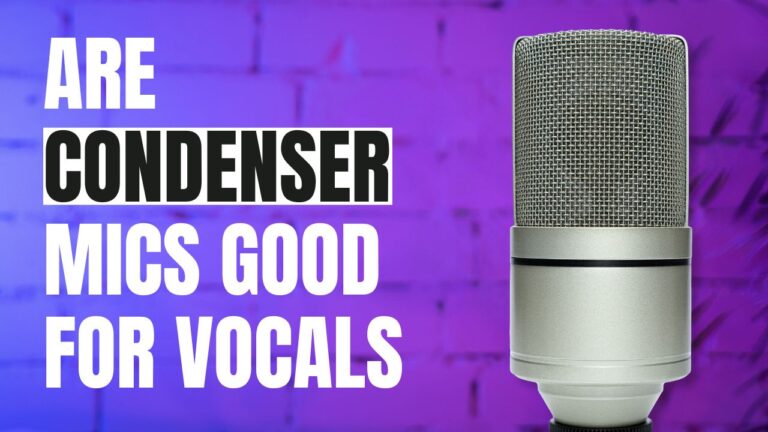Are USB Mics Good For Recording Vocals
USB mics are good enough when it comes to recording vocals, but there’s more to them that will want you to have them in your audio gear.
Recent years have witnessed a boom in USB microphone production, a fact which speaks for their popularity. While the fame is largely attributed to their affordable prices and ease of setup, USB microphones have stepped up the game in terms of sound quality too. You can find a decent number of USB microphones on the market that are at least as good as XLR microphones, if not better.
For what it’s worth, USB mics are still nowhere near in terms of sound quality when compared to a premium XLR microphone, especially when it comes to vocal recording. To be honest, the gap is quite wide, as far as premium XLR devices are concerned, and the inherent differences in the design may never allow it to bridge it. However, despite that, USB mics have found a footing in the industry and now control a major share of the audio gear market.
Let’s look at some of the reasons that make USB mics good for vocal recordings and several other applications.
What Makes USB Microphones Good For Vocal Recording?
Several factors join in to make USB mics decent devices for voice recording, which include but are not limited to the following:
1. Decent Sound Quality
The competition in the USB mic market is fierce, which compels manufacturers to come up with innovations to attract customers. Some of the leading manufacturers have fine-tuned the components of USB microphones, making them quite decent for vocal recordings. It’s not to say that these microphones are comparable to premium XLR mics, but again, the two are entirely different devices designed to serve specific purposes.
Although USB mics do not offer results that are generally considered “professional”, most people do not need those. A cinematographer or an established singer may need those results because they want their production to be impeccable. An average user, on the other hand, can make do with results as long as they are fairly clear and capture the essence of vocals, and USB mics are good at that.
2. Frequency Response
Frequency response describes how a particular microphone reacts to different frequencies on the spectrum. It is expressed in graphs, so the users are aware of what to expect from their microphone. The evolution in technology has allowed manufacturers to tweak the frequency responses and make them fit for a specific application.
For example, vocalists generally desire a microphone that can boost the lower notes so even the faintest of frequency is audible in the results. In contrast, some prefer their audio to be natural and accurate which can be achieved by flat and wide frequency response. You can find both types of microphones in the USB category, allowing you to pick the one that suits you the best.
3. Headphone Output
There are two ways to achieve perfect audio quality. You can either spend hours in post-production or monitor the audio in real time and adjust the equipment to get the right results. The latter can be achieved via a headphone jack which is available in most usb microphones.
You just have to plug a headphone inside the available jack and listen to exactly what is being recorded. It will allow you to make tweaks to your setup so you do not have to indulge in tedious post-production.
4. Intuitive Features
Besides a headphone jack, USB mics are equipped with a number of nifty features that offer you complete over the recording, allowing you to perfect it. Most usb mics come with a gain knob, multiple polar patterns, volume control, and mute control which come in handy during the recording process.
You can boost the faint frequencies via a gain knob and switch between omnidirectional and cardioid polar patterns to get the best results. Furthermore, the usb condenser mics do not require any other equipment for the phantom power. It is unlike traditional XLR condenser microphones that need phantom power via audio interface which is supplied through XLR cables.
The combination of these features makes a USB microphone more versatile too, allowing you to record acoustic guitar and other acoustic instruments.
5. Less Background Noise
An XLR microphone setup is known for capturing the nuances of different sounds which is because of its high sensitivity. However, the high sensitivity can backfire too, especially when the recording environment is not treated and there are electronic devices in the room. A USB mic, on the other hand, is less sensitive than an XLR mic, allowing better background noise rejection and producing clearer audio.
Furthermore, the cardioid pickup pattern of these microphones also helps in keeping the audio clear via off-axis rejection and focusing only on the primary sound source.
6. Convenient Pairing of Multiple USB Microphones
Podcasting, music recording, or any other application that requires multiple microphones can be easily executed by USB mics. You do not require audio equipment such as audio interfaces with multiple audio inputs, a mixer, or any other device for that matter. Just plug both microphones in the USB ports of your laptop or desktop and with a little software support, the setup will be ready to go.
Applications of a USB Microphone
A USB mic is suitable for a wide array of applications, including but not limited to:
1. Recording Video Calls
Tutors who offer online lectures can not only improve their communication during the video calls but also record it for the other students. A solid USB microphone offers significantly better sound quality than the built-in mics in your laptops, allowing you to upload a professional-sounding lecture on online platforms.
2. Recording Music
While XLR mics are the preferred choice when it comes to recording voice for music, you can also use a usb condenser microphone for the same job. The differences between the sound quality of both microphones can be compensated by quality recording software and creative post-production.
3. Podcast Recording
Market offers several decent usb mics for podcast recording. You can easily pair multiple usb mics with a single laptop without requiring additional audio gear. Furthermore, features like gain control, mute switch, and switchable polar pattern come in handy during podcast recordings.
4. Outdoor Interview Recording
A usb mic is a great option for outdoor interview recording. You can plug it into your laptop anywhere and start recording in excellent quality. It eliminates the need to carry heavy audio equipment like audio interfaces and mixers without compromising the results.
Conclusion
USB mics are decent devices for recording vocals. Certainly, they are not as good as premium XLR mics because of the inherent design differences, but then again, there are things that those premium mics can also not do. The point is, the two devices target different audiences and USB mics have just the right features, which are more than just sound quality, to tap its audience.
Frequently Asked Questions

Sharoon Shahid
Hi! I’m Sharoon Shahid, founder of Audiblearray. With a decade of experience in using mics, I’m here to guide you on your audio journey and save you from gear pitfalls!






